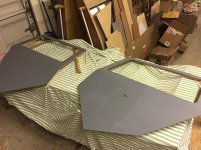Some good door info can be found here. http://www.supercub.org/forum/showthread.php?43342-PA-12-Seaplane-Door-need-advice-amp-ideas
Making closed end thimble strikes to drop and weld into the frame tubes is simple enough. When I did it I used 3/16 SS round locking rods and cut tapered ends to pull the door tight as the handles were rotated to close. The rods were bent 90* and pinned at the bellcranks with small cotter pins. Handles were from a truck canopy shop and had key locks. I did have a return spring. You can see it in the pics on the forward lock rod. The only time I had any issue was when I tightened the plexi against the foam tape and changed the strike backset enough that the doors wouldn't latch all the way. The doors would pop open in turbulence. Not fun when you're already wrestling with the plane to keep it in control.
Making closed end thimble strikes to drop and weld into the frame tubes is simple enough. When I did it I used 3/16 SS round locking rods and cut tapered ends to pull the door tight as the handles were rotated to close. The rods were bent 90* and pinned at the bellcranks with small cotter pins. Handles were from a truck canopy shop and had key locks. I did have a return spring. You can see it in the pics on the forward lock rod. The only time I had any issue was when I tightened the plexi against the foam tape and changed the strike backset enough that the doors wouldn't latch all the way. The doors would pop open in turbulence. Not fun when you're already wrestling with the plane to keep it in control.
Last edited:
































